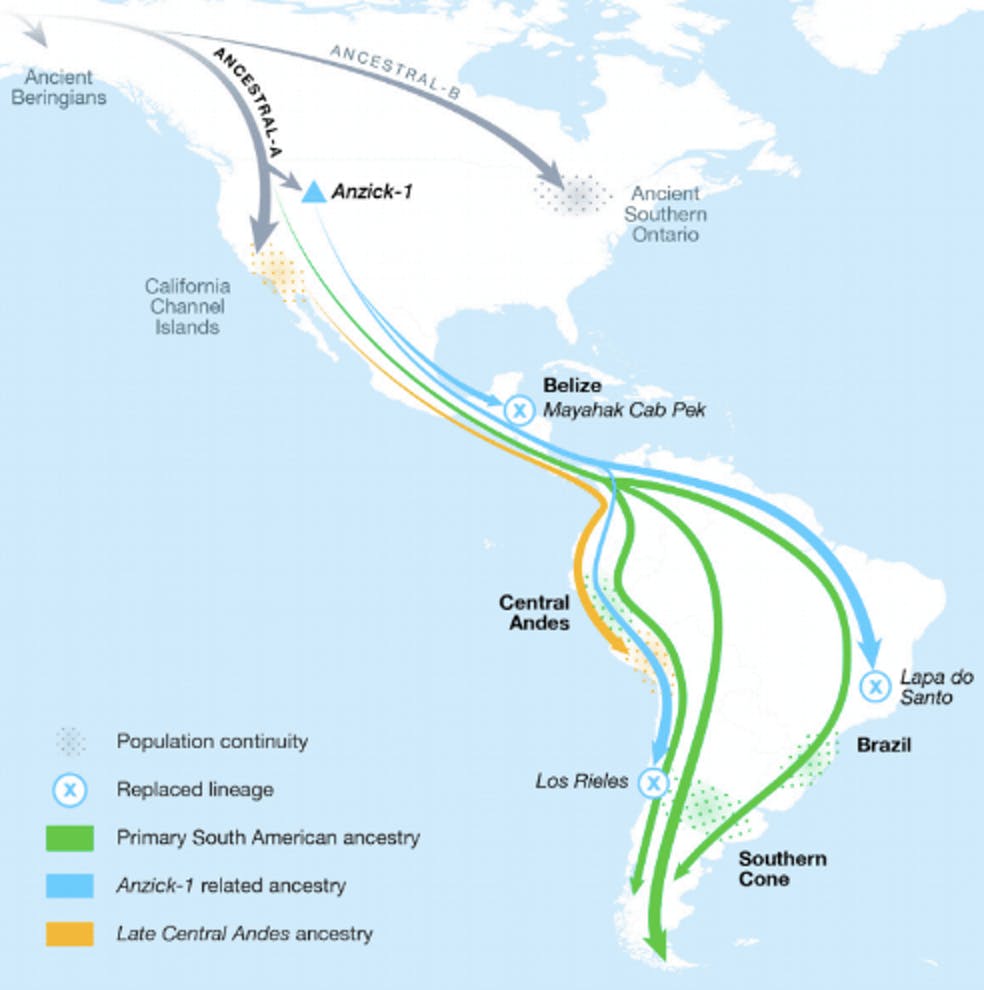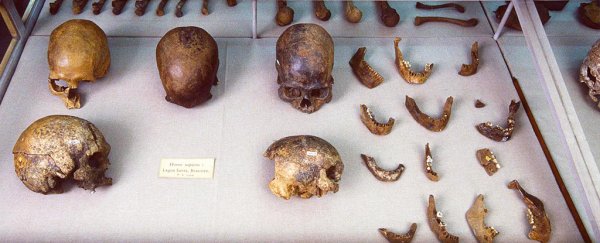Who were the first Americans? While we have some rough ideas, the answer to this question has long been up for debate.
Now, comparisons between two extraordinary sets of ancient American remains have added rich detail to the spread of ancient human populations through the New World more than 13,000 years ago. And it shows a surprising and far-reaching connection between native North, South, and Central Americans.
What started as a simple story of migration is quickly turning into an intricate web of movement and cross-pollination, revealing connections that stretch not just deep into South America, but perhaps around the world.
 (Michelle O'Reilly, Cell)
(Michelle O'Reilly, Cell)
Two separate research groups have compared genetic sequences taken from a range of specimens collected from Alaska to Patagonia to reveal new details on the expansion of native American populations.
The 'old' story on the arrival of humans to the American continents has been a fairly simple one, largely thanks to a relative lack of information.
Small groups of people slowly journeyed across the Bering Strait as the last great ice age melted away more than 20,000 years ago, taking thousands of years to branch out across the land and eventually into South America. That much we know.
The image we're left with is an inverted tree, with a solid trunk in the north and branches diverging and blooming with new cultures.
Of course, the story of human settlement was never going to be that straight forward. The map of human evolution around the globe, as we're learning, is anything but a one-way street ending in cul-de-sacs.
But while the beginning and end points are clear, the timing and precise movement of family lineages has been left to our imagination.
The remains of a toddler who died in what is today Montana some 12,700 years ago has provided two groups of investigators with a solid landmark to work from in their efforts to identify relationships between diverse populations.
So-called Anzick child is the oldest known burial in North America, discovered alongside tools representing a people who had until recently been long considered the first occupants of the continent, the Clovis culture.
One group of researchers compared DNA sequences from the Anzick child with those taken from another record holding specimen – the continent's oldest mummified remains.
Spirit Cave mummy is a body that was unearthed in northwest Nevada in the 1940s, and has contentiously been thought to represent an even older culture than the Clovis, based on its own unique tools.
The 10,600 year old remains were quickly claimed by the Fallon Paiute-Shoshone Tribe as an ancestor deserving repatriation, with a subsequent genetic analysis demonstrating it was more closely related to modern Native Americans than any other population around the globe.
Researchers have now identified a genetic link between the Anzick child and the Spirit Cave mummy, arguing even if they were culturally distinct, genetically they shared a relatively recent set of ancestors.
Drawing a line between Anzick child and the Spirit Cave mummy was just the first step. The team also showed there were links between the Anzick child's remains and 10,000 year old remains from Lagoa Santa in Brazil, with a common ancestor dating back around 14,000 years ago - a link between the Clovis culture and South American that wasn't expected.
A second international team of researchers independently analysed an astonishing 49 sets of remains from Central and South America dating as far back as around 11,000 years, also using Anzick child as a reference point.
They identified even closer relationships between the Clovis remains and 9,300 to 10,900 year old remains from Brazil, Chile, and Belize.
"These [findings] are fascinating as they open new gateways into archaeological and genetic research," co-author Nathan Nakatuska explained to Sarah Sloat at Inverse.
"It was previously not known that the Clovis culture extended into South America, and it is incredible that these people were able to migrate all the way through North, Central, and South America. In addition, the new migration into the Southern Andes was not previously known, and we are unsure what historical events led to this."
Solving the mystery of why such rapid separations occurred is now the big question. Making matters even more complicated, both teams identified further waves of genes entering populations spreading north and south over the millennia.
None of these movements replaced existing populations, but rather show a melting pot of migrations that ebbed and flowed. That inverted tree idea is quickly being replaced by a far more complex network, which has exploded and settled in multiple directions over thousands of years.
Stranger still is the hint of Australasian ancestry slipped in among the genes, hinting at a deeper mystery that so far has few clues to go on.
"How did it get there? We have no idea," geneticist José Víctor Moreno-Mayar of the University of Copenhagen told Lizzie Wade at Science Magazine.
There's little doubt that with better technology and more genetic samples we'll continue to unveil the rich tapestry of early American cultures, one that could stretch further than we ever imagined.
